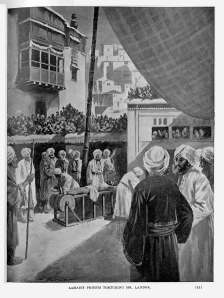Yesterday, Chris Bell’s Facebook feed alerted me to an article by Vice, describing the phenomena of ‘tulpas’ and the ‘tulpamancers’ who create and nurture them. For those of you who may not be familiar (as I was not), tulpas are beings created in the imagination of the tulpamaner, but which acquire their own sentience. According to Vice, tulpamancers spend some 200 to 500 hours in intense focus ‘forcing’ their tulpas to appear. Once that happens, though, tulpamancers are convinced that their creations have independent mental lives of their own. They can hold conversations with their host, dictate letters and even fall in love.
Really, there’s too much to describe. Go read the article, then come back. You won’t regret it.

I’m going to refrain from commenting on wether this is weird or not (Vice certainly thinks it is). Instead I’m going to focus on the Tibet angle. Because there’s a Tibet angle. Again, according to the Vice article, creating tulpas is believed to be a Tibetan practice, brought back by Alexandra David-Néel and described in her 1929 book, Magic and Mystery in Tibet. Vice quotes David-Néel, and while it fails to provide page numbers, it does provide a quote. With that quote and the search function in Google Books, I can tell you that the relevant passages are on pages 313-315 of the 1971 Dover reprint. I have to admit, I was kind of surprised to find that Vice had not misquoted her: David-Néel does, in fact, claim to have created a tulpa, described as a phantom that she created in her mind over several months of meditation, but which, once created, had a mind of its own. While many contemporary tulpamancers seem to prefer anime characters, David-Néel’s tulpa was, in case you were wondering, a fat monk.
Needless to say, I have never heard of anything like this from any Tibetan. The term is certainly Tibetan (སྤྲུལ་པ་). And the term is closely related to the common idea of the tülku (སྤྲུལ་སྐུ་), that particular individuals are born as the emanations of deities or the reincarnation of previous masters. To me, however, there is a pretty big difference between saying so-and-so is the reincarnation of such-and-such previous master, and conjuring independent entities out of thin air, who then proceed to live entirely within their creator’s minds.
So what to make of all of this? David-Néel was a pioneer, and we should all be grateful for her work. While the term tulpa certainly exists in Tibetan, and the practice does bear some resemblance to the theories that account for tülkus, I have never heard of a Tibetan creating, ex nihilo, a being with its own consciousness that only lives in the host’s mind. My suspicion, as you have probably guessed by this point, is that this is yet another instance of western pop culture picking up a Tibetan idea and then running with it on their own, far beyond its original context. (See also: Batman does Tögal). Or maybe I’m just ignorant. If so, let me know in the comments. I’d be fascinated to see or hear of something like this in a traditional Tibetan context.



